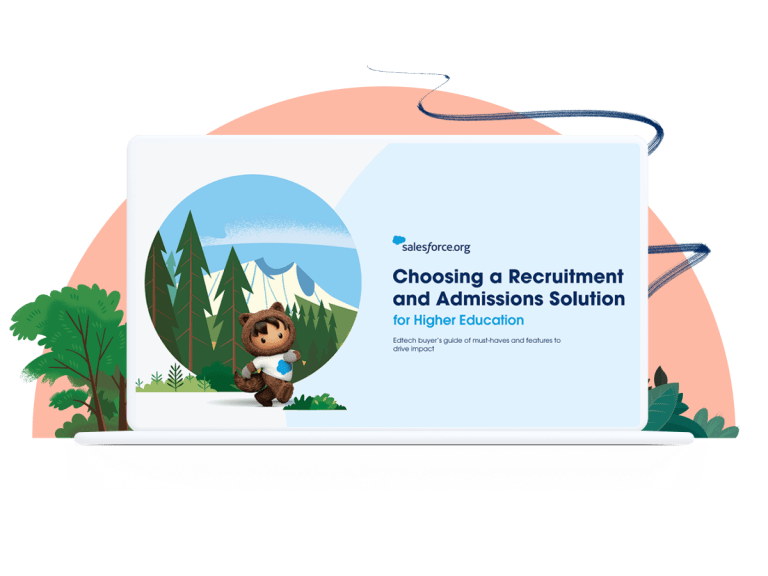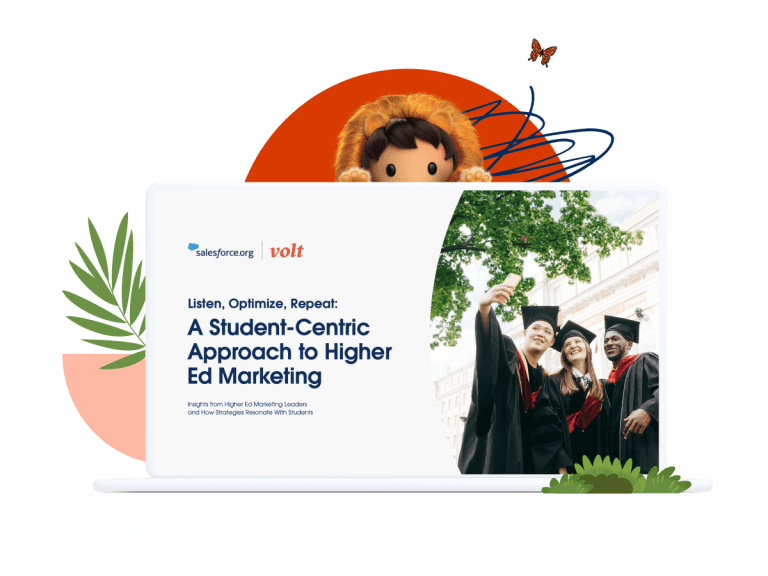Student recruitment is one of the most critical pieces of the student experience as it sets the foundation for the rest of their time at college. Creating a good first impression and supporting prospective students during this time can help foster a sense of community and belonging well before a student steps on campus. Moreover, this stage of the student lifecycle isn’t just critical for students; it’s vital for the long-term sustainability of institutions as they seek to achieve enrollment goals and reduce summer melt.
So how can universities attract potential students? What strategies should be implemented in a digitally dominated environment? In this guide, you’ll learn the answers to these questions and see how your institution can create personalized recruitment experiences that nurture prospective students at every step.
Student recruitment today
The goal of higher education recruitment is to get the best-fit students admitted to your institution. There are several ways to do this. Traditionally, institutions filled their recruitment funnels with legacy tactics like purchasing lists or relying only on in-person events. Today, those tactics alone aren’t effective. Institutions must adopt a digital-first, agile approach to generate the best results.
Earning a degree is an investment that students hope will set them up for a prosperous career, making this factor a critical piece in their college selection process. According to the Third Edition of the Connected Student Report, nearly half of students reported selecting their institution based on career prospects. Students want to see how your school fits their needs, personality, and career goals to justify their investment. It’ll take a personalized and engaging college recruitment strategy to win them over.
Three factors shaping student recruitment in higher education
First, it’s essential to look at the broader state of today. Understanding these three significant factors will explain why focusing on student recruitment is more important than ever.
- Enrollment is down across the board. Enrollment numbers have been on the decline since the start of the COVID-19 pandemic. In fact, postsecondary institutions have lost nearly 1.3 million students since spring 2020, according to data from the National Student Clearinghouse Research Center. Overall, enrollment dropped by about 4%. Community colleges were hit the hardest, with a 7.8% decrease from spring 2021 to 2022. Despite the growing return to normal campus operations, enrollment numbers don’t seem to be improving. Institutions need to understand why enrollment is dropping in order to create effective student recruitment strategies.
- The education landscape is rapidly evolving. The pandemic accelerated the use of technology in a virtual environment so it’s no surprise that higher education has faced dramatic shifts here as well for learners, faculty, and staff. Remote learning is now the norm for many institutions, but adapting hasn’t been easy with so much competition. Additionally, alternative online higher education offerings with a focus on technical skills and certificate training have gained more visibility and a survey by Strada reveals most Americans would choose to pursue a certificate or license program over other educational avenues. As the education experience changes alongside growing numbers of alternative options, enrollment numbers at higher education institutions are suffering as a result. To keep up, institutions will need to adopt new technologies and show prospective students during the recruitment process why they are different and the value they are able to offer.
- Educational inequities persist. A startling trend is looming for freshman enrollment when broken down by race. From 2021 to 2022, Black freshman enrollment decreased by 6.5%, with registration at community college institutions decreasing by a whopping 44% over the last decade. Out of all races tracked for freshman enrollment, Black students were the only race to see a decline in 2022. Women experienced significant enrollment declines, too. Institutions saw a decrease of 4.6% for this group, more than doubling the loss experienced in 2021.
In addition, first-generation students are less likely to graduate compared to their counterparts. As education inequities continue to persist and widen, there’s an opportunity for institutions to bridge the gap by focusing on diversity, equity, inclusion (DEI) in their recruitment efforts.
With declining enrollment rates, rising costs, shifting attitudes, and increased competition, recruitment staff must work more productively and strategically than ever before to attract and engage prospective students.

Supercharge Recruitment of Digital-First Students
Learn how college recruiters and marketers can best engage prospective students.
Lay the groundwork for effective college recruiting strategies
Institutions are tasked with managing costs and increasing revenues while improving staff productivity. They must do all this while appealing to prospective students in an intensely competitive higher education environment. Just as businesses need an organized plan to drive long-term success, so do colleges and universities. To create a successful campus recruitment strategy, institutions need to set clear, specific goals that are measurable and achievable. Institutions simply can’t wait six to twelve months to adjust their recruitment and admissions plans. They need dynamic solutions and flexible platforms that allow them to innovate in order to attract and enroll students effectively.
Bring the right prospects to the top of your recruitment funnel
Universities today can no longer rely solely on legacy tactics or third-party sources to find the best-fit prospects for their recruitment funnel. They must seek these potential students out themselves. In a highly competitive landscape, they must shift strategies to a digital-first approach that prioritizes speed along with a personalized and engaging experience to drive prospects to the top of their funnel. Building personalized relationships from the very start of the recruitment process begins with institutions addressing these questions:
- Where can we find more prospects who fit the profile of our current student body?
- How can we differentiate ourselves from the competition so prospects feel a sense of connection to our university?
- How do we provide an engaging and personalized digital-first experience?
- What tools can we use to gain insights from our interactions with prospects? Are we able to improve our strategies based on these insights?
To help answer some of these questions, institutions should use key enrollment indicators (KEI). This includes defining enrollment cohorts, collecting student lifecycle data, defining metrics of success, developing an enrollment model, and using that model to benchmark progress to better understand areas for improvement. Institutions should strive to hit specific enrollment targets over a certain period of time and track that progress carefully, allowing room to adjust tactics as needed. This is critical for creating a sustainable recruitment process.
Evaluate technology and techniques in place
Now that you have a better understanding of who your ideal student is, it’s time to attract them with the right technology and techniques. According to the Connected Student Report, of the students surveyed who said they had a great university experience, 69% felt their experience was personalized. Today, students expect tailored communications, from applying to a university to graduation. Institutions need modern tools and intelligent data to make that happen. But an average institution uses 35 different applications to manage the student journey, according to a Nucleus Research report. This can lead to poor data integration, siloed communication, and a slower, less personalized engagement process throughout the recruitment funnel.
To create a personalized process every step of the way, universities need technology that:
- Integrates data into one platform
- Analyzes information into actionable insights
- Includes end-to-end marketing
- Provides front-line assistance with chat bots
- Allows interactive and customizable emails
- Offers social media recruiting tools
- Streamlines support with case management automation
A system that offers these key features provides recruitment and admission staff with valuable insights from the beginning of the engagement process and reduces friction during the application stage. This was the case for Indiana University – Purdue University Indianapolis. After switching to a new customer relationship management (CRM) system that included these features, the university tripled the number of personalized emails sent — resulting in a 7% increase in conversion from applicant to enrolled student. Using an integrated platform can help institutions engage prospective students at scale and in a manner that drives results.

Choosing a Recruitment and Admissions Solution
Edtech buyer’s guide of must-haves and features to drive impact.
Recruiting ideas to attract and engage prospective students
Achieving a sustainable student recruitment strategy takes creativity and a digital-first approach. Creating a personalized experience from the very top of the funnel down to enrollment is crucial. The strategies listed here can help.
1. Define your college’s brand
Students looking to find the right institutional fit assess several pieces of information. However, one of the most important pieces is the why behind your institution. What is the primary mission of your school? What sets it apart from others? What special programs do you offer that students can’t find elsewhere?
When prospective students look up your institution’s website or social media channels, they should be able to determine the why quickly. This means spending time evaluating and, if necessary, crafting your institution’s brand that is consistent across various media channels. Not only is branding crucial on your website, but it’s also key to have a presence on Facebook, Instagram, and YouTube — these are the most popular social media platforms prospective students use to assess a potential institution.
Universities should ask themselves:
- Is our “why” relevant and consistent on our website and social media channels?
- Do we have a tagline that is consistent with our brand?
- Are our student cohort demographics reflected in our brand?
- What are our strengths? Are we showcasing them?
Olivet Nazarene University is a master of branding that plays on its strengths. One of their most successful initiatives involved better serving the needs of continuing students, those who had dropped out due to financial issues, poor grades, or other external challenges. They created a groundbreaking, free, self-paced online program. It was a success, seeing a 1,000% increase in new continuing students and a 30% reduction in recruitment costs.
Their branding reflects the success of that initiative and what makes their school so unique. This small, low-cost option created an environment welcoming to otherwise marginalized students. On their website, they highlight their tagline in bold at the top of the page and include a large graphic that features their ranking from U.S. World and News as one of the best-valued schools in the Midwest. Across their social channels, they have the saying, “We believe. You belong.” It’s easy to see their why in the first few seconds on their website and social media channels.

Adopting a Student-Centric Approach to Higher Ed Marketing
Learn actionable best practices from dynamic industry leaders and students.
2. Use personalized and engaging communication
Understanding how and what kind of communication your target audience prefers is critical in order to turn prospects into enrolled students. It’s likely your recruitment office will be spending a lot of time targeting the Gen Z population since they’re the biggest demographic entering their prime college years. To win over the hearts of this generation, you’ll need personalized and engaging communications delivered on the channels they prefer.
So, how do you do that? Here are some ways to create a more personalized experience throughout the recruitment process.
- Utilize social media. This is critical when targeting prospective students. If you want to reach them, find out where they spend most of their time online such as YouTube, TikTok, and Facebook. Some ways to utilize social media is to do paid advertising campaigns, publish content focused on storytelling student success, or provide live Q+A sessions. Understanding who you’re trying to target and shifting resources to the appropriate platform can increase your institution’s visibility and push more prospects to the top of your recruitment funnel.
- Find out preferred contact methods. When prospects sign up for a newsletter, visit the campus, or reach out via phone, follow up with how they prefer to receive future communications. Do they prefer emails? Text messages? Phone calls? Ask them if the interaction is in-person, or send a follow-up email or text with a survey. Make sure this information is put into your CRM. Chances are, if they’re reaching out for information, they’re a highly interested prospective student. Ensuring you engage using their preferred contact method means you have a better chance of driving them to the final stage of the recruitment process.
- Set up automatic, personalized updates. Once you know a prospect’s preferred contact method, make sure to deliver customized updates routinely. For example, if a student shows interest in pursuing an engineering degree, make sure to send them program events or testimonials from alumni who currently work in the field. Personalized and routine updates show that your institution listens and understands the goals and needs of a prospect — an indicator they will be treated with the same great care if they become an enrolled student.
- Utilize chat bots. Chat bots are a great way to free up your staff while simultaneously delivering a personalized experience. Good chat bots incorporate data from a CRM and use AI to tailor conversations. Let’s say a prospective student is looking for a better idea of how much their tuition will be. They can use your site’s 24/7 chat feature and find an answer quickly — while at the same time, the chat bot can push this conversation into your admissions CRM so you can keep track of every engagement. You now have more details on your prospective student, such as concerns about tuition costs. A staff member can follow up shortly and find solutions that suit the prospective student’s needs.
- Use a CRM that integrates data. All of the methods explained here require an agile CRM platform. It’s critical to use a platform that integrates data across various systems into a unified place and includes tools to take action on that data. This means your staff can be more productive and focus on converting high-priority prospective students.
Marketing Cloud for Recruitment and Admissions Demo
3. Showcase university life in multiple ways
More than 55% of students selected location as an important factor in where to enroll, according to Salesforce’s Third Edition Connected Student Report. Prospective students want to understand university life better. They need to be able to see themselves living and learning in an environment that suits their personality. Perhaps dorm arrangements are most important to them or networking opportunities in their field of interest. Or maybe they’re more interested in whether or not the surrounding area has hiking trails or beach access. Showcasing university life in multiple ways helps prospective students gain better insight into what enriching experiences they can have inside and outside of the classroom.
Here are some ways to showcase university life:
- Create a “Day in the Life” video series. If you’re looking to reach Gen Z prospects, using YouTube content is a good way to grab their attention with student generated content. It’s a great way to influence a prospect’s decision-making process in a positive way. Some current students may already have their own YouTube channels featuring a “day in the life” video about your school. You can get permission to use their video or incentivize students by creating a yearly or semester scholarship that selects a student to create content throughout the academic year.
- Student takeover social media days. Another way to easily incorporate student-generated content on your institution’s social media channels is to do student takeover days. Perhaps once a month, students write posts and create short videos walking though what their typical day is like. Even better if you can incorporate athletes, student parents, or other diverse student experiences.
- Highlight a hybrid learning environment. Today, more than 70% of enrolled students work full time or part time. Balancing school and work can be challenging; thus, finding an institution that offers a flexible and hybrid learning environment may be a priority for prospects. Demonstrating how your school makes learning while working easier will be an essential part of the recruitment process. You can do so by highlighting students who juggle both and are succeeding at your institution.
- Focus on the surrounding area. Besides campus life, prospects want an overall idea of what the surrounding area offers. Be sure to include shopping, restaurants, nightlife, parks, and nature they can experience. Location matters in the decision-making process, so include as much information as possible.
- Maintain a dedicated webpage for university life. Students worldwide say social events, more than classes, help them feel connected to their university’s community. As a result, more than 50% of students say they want more in-person events and activities at their schools, according to the third edition of the Connected Student Report. Your homepage should have an easily-accessible, linked page that showcases university life and the activities and events you offer. Updating it regularly, incorporating lots of media, and leading with student-led stories are great ways to highlight what makes your university’s culture unique.
One university using these strategies skillfully is the University of Wisconsin-Madison. On their homepage, they offer virtual campus tours, including virtual tours of the surrounding area and outdoor activities. Students can even explore what to expect from all four seasons in Wisconsin — an excellent feature for out-of-state and international prospective students. A separate page features the Wisconsin Experience. Prospective students can dive deeper into four categories based on the school’s mission and read detailed student stories highlighting the school’s diverse student body. Wisconsin-Madison provides a lot of information in the form of multimedia with a focus on student stories to help prospects get a feel of what life is like beyond the classroom at the university.

“If you want your institution to survive and thrive for the next 10 or 20 years, you can’t stand still. The education landscape is becoming more competitive, and student expectations are changing. You cannot expect to successfully recruit students if you can’t serve them in the way they expect to be served or with the speed they expect to be served.”
– Alan Ng, Director of Information Technology, Division of Continuing Studies at the University of Wisconsin-Madison
Learn more about how the University of Wisconsin-Madison maximizes outreach while addressing the recruiting needs of different departments.
4. Focus on digital and in-person events
Online or in-person, many institutions are adopting a hybrid event approach when engaging with with prospective students. These events are pivotal in pushing students to the top of your recruitment funnel. Below are some event ideas to get you started:
- Focus on high school students and their parents. Local high schools near your university offer a great pool of potential students. Olivet Nazarene University does a great job tapping into this recruitment strategy by hosting Purple and Gold days — where only high school seniors and their parents can visit the campus with customizable tours. They also offer virtual tours, Just for Junior tour days dedicated to high school juniors, and holiday tour dates so prospects can get a taste of high-energy days on campus. When hosting these types of events, make sure to collect contact information from students who show interest, and follow up with them through automated, personalized engagement tools.
- Offer live-streamed, student-led campus tours. Take digital tours to new levels with live streaming events led by current students. A livestream allows prospects to ask questions in real-time and experience a sense of community with fellow tour takers.
- Hold first-generation student seminars. First-generation students make up 40% of enrolled college students, yet they disproportionately enroll in less-selective schools, despite being qualified for them. The reasons for this may be financing (selective schools tend to be more expensive), unfamiliarity with the college application process, or a general mindset that they don’t have the ability to be accepted. First-generation students can need more support. When you offer seminars on campus or digitally, they have an opportunity to explore the ways your school can set them up for success. What kinds of scholarships do you offer? What about alternative financing options? Do you provide one-on-one application help? Institutions can stand out from the crowd by answering these questions and taking the time to nurture the relationship with these prospective students. Hosting high school events in low-income communities and creating transfer pathway programs in partnership with local community and technical colleges are some ways to attract talented individuals.
5. Ask alumni to help you recruit prospective students
According to the Third Edition of the Connected Student Report, 47% of students select their institution for career prospects. Pursuing a higher education degree at a private, non-profit institution costs, on average, $33,000 a year, so students want to be sure their investment will pay off. And with increased competition from alternative higher education options, institutions need to leverage every tool in their toolbox.
Perhaps one of the best ways to drive home the value of a degree is to get help from alumni. They can offer testimonials and demonstrate future career opportunities if prospects choose your school. Here are some ways to get the support of alumni in your recruitment efforts:
- Hold alumni Q&A events. Alumni and prospective students based anywhere in the world can connect through digital events such as Question & Answer (Q&A) sessions. You can personalize these Q&A sessions by hosting events for first-generation college students, student athletes, or students with children.
- Highlight alumni success stories. Through email marketing campaigns and on your website, highlight alumni success stories. For example, if you know a prospective student who showed interest in your theater program, you can send them emails on alumni who have created successful theater careers post-graduation. Sending invitations to theater department virtual and in-person events can also be a great way for alumni and prospects to connect with current students and faculty. This can be especially important for prospective students who may need a little extra push toward the end of the recruitment funnel.
- Provide mentoring opportunities. With career prospects high on many students’ priority lists, offering career support before, during, and after a student’s educational journey is vital. Do you have mentor opportunities in place? The Q&A sessions mentioned above are a great exploration tool for prospective students. You could also partner students with a dedicated alum mentor for their educational journey, allowing them to build a trusted relationship. Opportunities like this could sway prospective students’ decision to choose your school.
Higher education institutions today are often ranked by their students’ ability to graduate and obtain lucrative employment. Emphasizing alum success and creating mentorship opportunities can persuade prospective students that your institution is a worthwhile investment, leading to higher enrollment rates and increased revenue and better revenues.
Higher education recruitment is a foundational piece of the student experience — a good first impression helps students develop a sense of connection to the university before stepping foot on campus. Recruitment efforts need to be nurtured, evaluated, and assessed regularly. Institutions need to consider their recruitment office’s goals, tools, and techniques to find the right students. One such method is to create personalized engagement throughout the recruitment funnel. Universities can do this by adopting a digital-first approach that plays up their strengths through branding, focusing on targeted marketing strategies, and hosting specific hybrid events tailored to prospects’ needs.
Having the right technology to deploy these strategies is vital. With help from Salesforce, universities can create a recruitment process that fits perfectly into their goals.

Recruitment & Admissions
Deliver a connected journey with Student 360.
